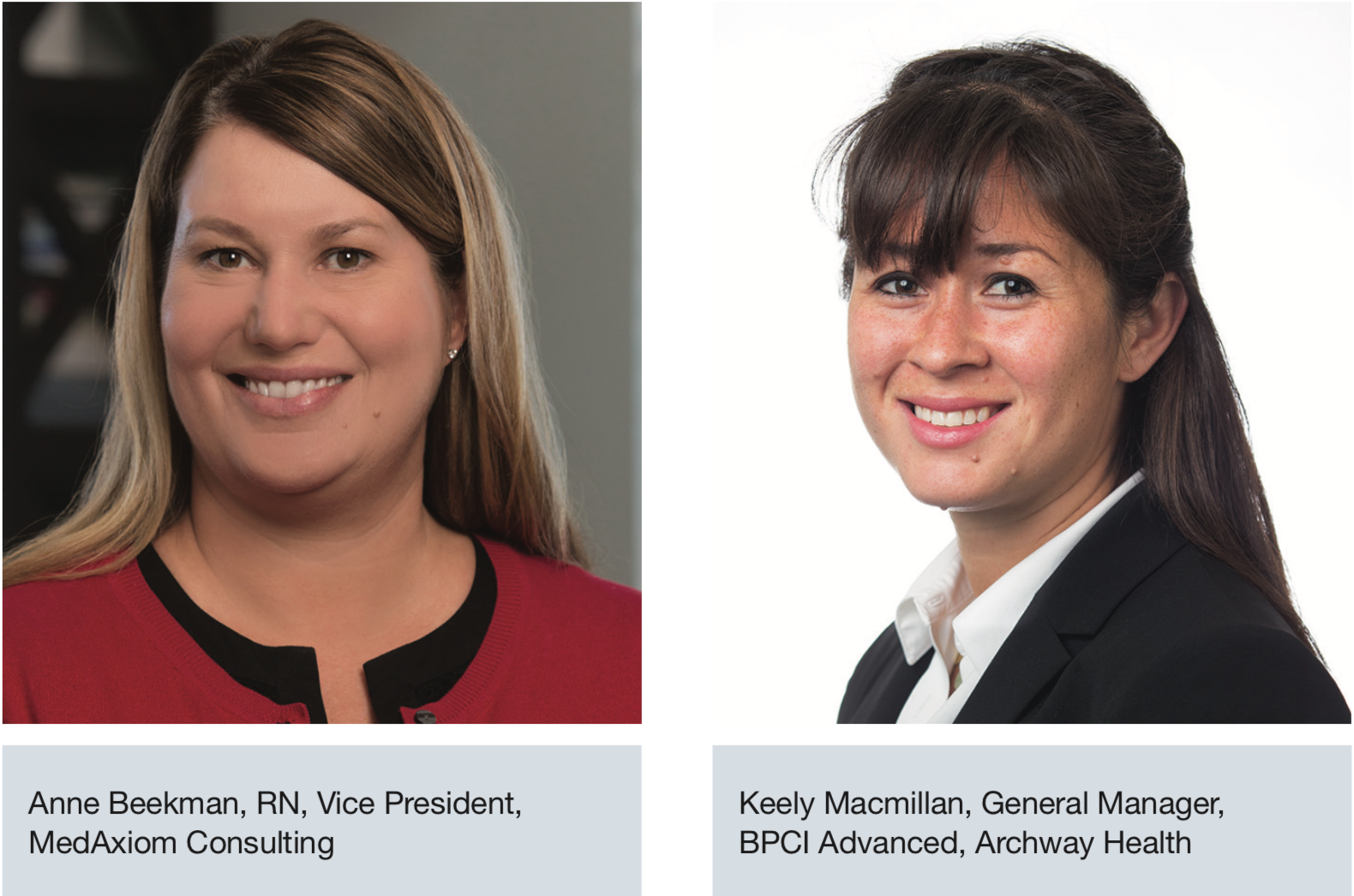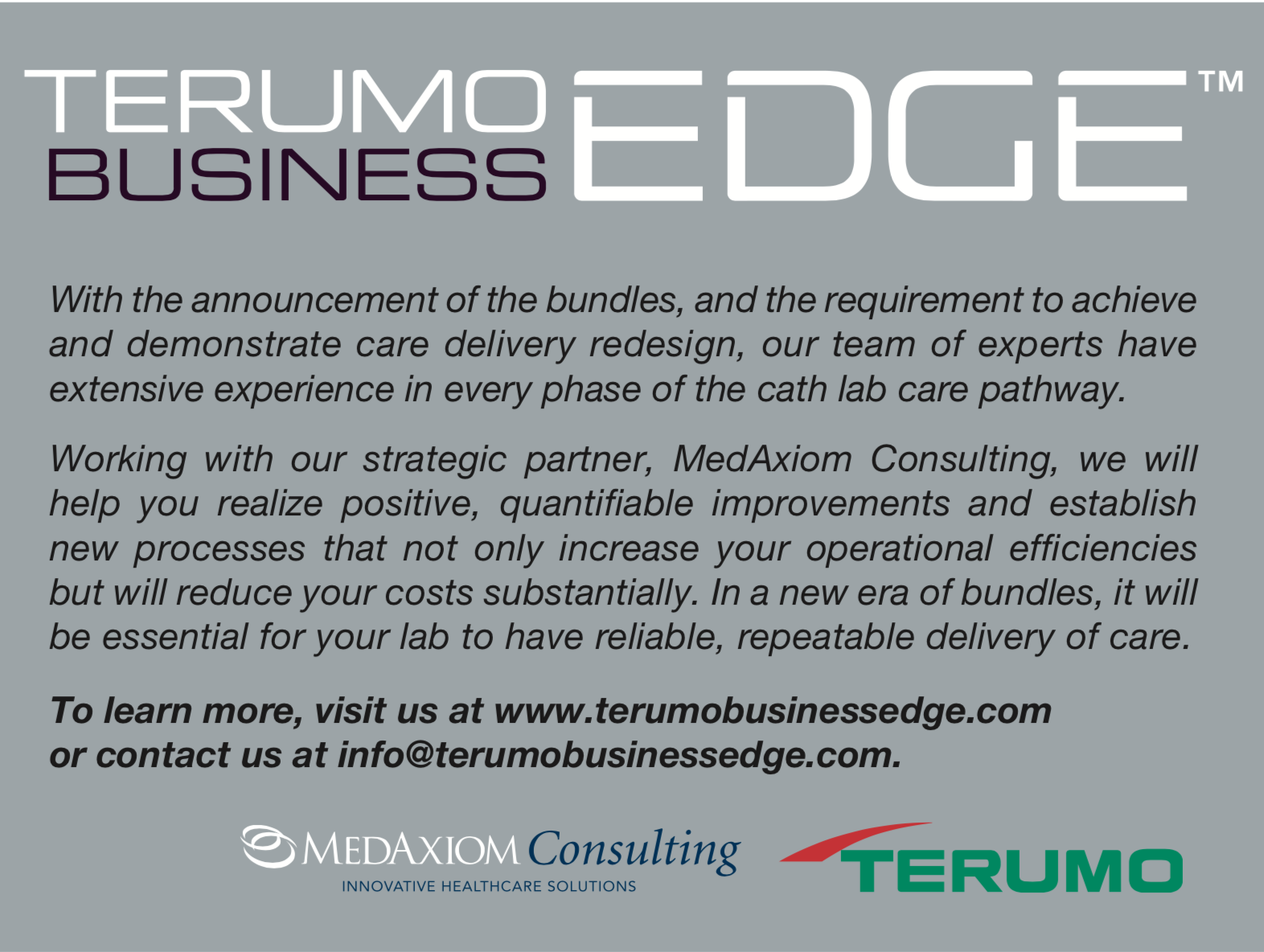Bundles are Here. Where are the Opportunities?
In this month’s article, we have asked Anne Beekman, MedAxiom Consulting, and Keely Macmillan, Archway Health, to discuss what the new voluntary bundles offer as an opportunity for cath lab programs considering percutaneous coronary intervention (PCI), specifically outpatient procedures. Anne and Keely provide a great overview of where the costs are and the opportunities that exist to reduce your costs. Archway provides tremendous insight as to where the costs are bucketed, thus giving us the perspective we need to understand costs in a more granular aspect. — Gary Clifton, Vice President, Terumo Business Edge
 Last year, when the Centers for Medicare and Medicaid Services (CMS) released the new episode payment model (EPMs), something was missing, and that something was the inclusion of any outpatient procedures. Primary PCI was included for work done during an acute event, but the first EPM release (which was cancelled in November 2017) did not include outpatient PCI or cardiac rhythm management (CRM) devices in the new episode payment models. The cancelation of EPMs has been followed by the release of Bundled Payment for Care Improvement (BPCI) Advanced, which did add outpatient procedures; for cardiology, this included outpatient PCI and cardiac defibrillators. Clearly, through the new bundle program, CMS expects to see lower costs, higher quality, and better coordination of care. Programs that can achieve that goal will benefit from financial gains.
Last year, when the Centers for Medicare and Medicaid Services (CMS) released the new episode payment model (EPMs), something was missing, and that something was the inclusion of any outpatient procedures. Primary PCI was included for work done during an acute event, but the first EPM release (which was cancelled in November 2017) did not include outpatient PCI or cardiac rhythm management (CRM) devices in the new episode payment models. The cancelation of EPMs has been followed by the release of Bundled Payment for Care Improvement (BPCI) Advanced, which did add outpatient procedures; for cardiology, this included outpatient PCI and cardiac defibrillators. Clearly, through the new bundle program, CMS expects to see lower costs, higher quality, and better coordination of care. Programs that can achieve that goal will benefit from financial gains.
If the goal for CMS and BPCI Advanced is to differentiate this new program by its encouragement of cost savings, quality, and coordination of care, the natural question may be, how much separation is there between cost and quality today? The data around this question might surprise you. Archway Health is an experienced BPCI convener; their analysis of Medicare fee-for-service claims reveals an average wage-adjusted cost for an outpatient PCI 90-day bundle of $15,900. If you are thinking that this cost must be located almost entirely in procedure costs, think again. Of the $15,900 spent during the outpatient PCI 90-day bundle, 30%, or $4,800, represents cost that occurred after the anchor PCI procedure. So, what does the cost breakdown look like (Figure 1)?

Data show that 70% of the cost in the outpatient PCI occurs during the procedural event itself. A significant portion of these costs has been tied to length of stay (LOS). Same-day discharge can lead to significant patient and provider satisfaction, not to mention a reduction in the direct and indirect costs associated with the cost of keeping patients overnight unnecessarily. Does it surprise you that the national readmission rate following an outpatient PCI is 11%, translating to 13% of the cost of the 90-day outpatient PCI bundle? Readmissions for outpatient PCI account for an average of $2,000 of the bundle cost. This includes both facility costs and Part B costs. Keep in mind, the definition of a readmission in a bundle is different than the definition used in the Core Quality Measures program. Hospitals became good at managing readmission rates in the Core Quality Measures program by managing inpatient admissions where the patient was readmitted as an inpatient. Outpatient care was not included in the readmission rates in the Core Quality Measures program. The bundle is different: with a few exceptions such as trauma, cancer, or transplant care, all costs (both inpatient and outpatient) are included in the 90-day outpatient PCI bundle.
Can the costs of post-procedure care be successfully managed? In order to answer that question, it is important to understand why an outpatient PCI patient is readmitted. The top three reasons are: for another procedure involving placement of a drug-eluting stent, heart failure, and gastrointestinal (GI) bleeding. As programs have become more sensitive to complications from excessive radiation and/or contrast-related kidney injury, there can be good clinical judgment behind the decision to stage elective PCI procedures. However, in order to avoid staging, risks can be mitigated through the use of best radiation safety practices. The use of a lower frame rate, taking fewer pictures, and the use of saved images may help reduce dose and avoid the need to stage procedures. Programs can also do more prescreening work to determine risks of long-term antiplatelet therapy and adjust stent selection accordingly. Consider updating your NPO (nothing by mouth) criteria so patients come into the procedure well hydrated, reducing the potential for contrast-induced nephropathy. Avoiding any and all of these complications has benefits today and in the bundle payment model. These reasons for readmission may not be a surprise, but consider that the next step for these patients with acute kidney injury or GI bleeding may be home care or skilled nursing care, and that these costs are tied to the initial event — the outpatient PCI — and included in the overall cost of the bundle. Readmissions and added care needs beg the question: if we as care providers get better at owning the care of the patient during handoffs, can we prevent these events? What we know from other bundle work is that the answer is yes — pre-procedure optimization, along with safe and effective handoffs, reduce complications to patients and increase upside payment opportunities to providers and hospitals. Is there a high-risk readmission timeframe for the outpatient PCI patients that providers should focus on? The rate of readmission is greatest in the first 30 days post procedure, with 42% of readmissions occurring during this time period, 31% during the second 30 days, and 27% during the last 30 days. This is a good reason to follow up early and ensure the emergency room is not the only off-shift option your patients have. Patients who have undergone cardiac procedures are rightfully sensitive to any chest pain-type symptoms. Providing these patients with a timely and expert off-shift consult option makes sense and can reduce unnecessary worry, while facilitating action when required.
After reviewing the anchor outpatient PCI procedure and readmission during the 90-day bundle, the next opportunity is the 9.5% spent on post-procedure hospital outpatient services. What exactly is included in this category? The breakdown for this section is 63% procedural, 23% for an E&M visit (evaluation and management, likely representing a follow-up office visit), 6% for imaging, and 3% for lab tests. The remaining 5% was spent on a variety of services. The largest section of outpatient cost is the 63% spent on secondary procedures. The procedures in this section are as follows: 65% are outpatient PCI, 10% are pacemakers, 9% are procedures on other vessels (other than head and neck), 4% are diagnostic cardiac catheterizations, and 3% are cardioversion procedures. These procedures account for 90% of the costs in the outpatient. At first glance, it may seem like all this care is necessary and expected. However, let’s dig a little deeper and ask ourselves some questions. What if some of the procedures done are related to site complications? Are there solutions like growing your radial program or performing anatomical site marking for required femoral work? Perhaps not all E&M visits or imaging workups are necessary? Programs that are well-versed in bundle care know that turning the spotlight on themselves is essential to finding out what care is value added to patient outcomes and what care is a historical exercise.
Participating in any of the voluntary bundles will require work, time, and expanding the patient care team. If all this seems too complicated and the thought is to wait until this becomes mandatory, consider that if programs can’t get competitive in a government payment model, generating a positive margin may be impossible.
After reviewing the data presented by Archway Health, we believe this work should be seen as a tremendous opportunity. Every person that works in healthcare can identify a way to streamline what we do, and provide lower cost and higher quality care to patients. Perhaps the best news is that in the past, healthcare workers tried to do this because it was the right thing to do. Bundles give programs the chance to do this work really well and be paid for their success.
Reference
- Amin AP, Patterson M, House JA, et al. Costs associated with access site and same-day discharge among Medicare beneficiaries undergoing percutaneous coronary intervention: an evaluation of the current percutaneous coronary intervention care pathways in the United States. JACC Cardiovasc Interv. 2017 Feb 27; 10(4): 342-351.











